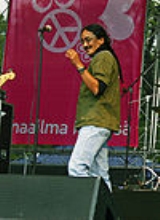
Gurung
Encyclopedia
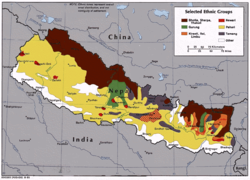
Nepal
Nepal , officially the Federal Democratic Republic of Nepal, is a landlocked sovereign state located in South Asia. It is located in the Himalayas and bordered to the north by the People's Republic of China, and to the south, east, and west by the Republic of India...
. Gurungs, like other east Asian featured peoples of Nepal such as Sherpa
Sherpa people
The Sherpa are an ethnic group from the most mountainous region of Nepal, high in the Himalayas. Sherpas migrated from the Kham region in eastern Tibet to Nepal within the last 300–400 years.The initial mountainous migration from Tibet was a search for beyul...
, Tamang
Tamang
The Tamangs are the ancient and original inhabitants of the mountains and plains of the Himalayan regions of Nepal and India. Their ancient capital being Yambu - modern day Kathmandu. They have their own distinct culture, language and religion. Their ancestral domain is popularly known as...
, Thakali
Thakali
The Thakali are ethnolinguistic group originated from the Thak Khola region of the Mustang District in the Dhaulagiri zone of Nepal. Thakali, like Mutanggi their ancestors, culture and traditions are traced back to ancient himalayan region...
, Magar, Manaaggi, Mustaaggi, and Walunggi, are the indigenous people of Nepal's mountain valleys. Their ancestors practiced Bön (shamanism), later converting to Tibetan Buddhism
Tibetan Buddhism
Tibetan Buddhism is the body of Buddhist religious doctrine and institutions characteristic of Tibet and certain regions of the Himalayas, including northern Nepal, Bhutan, and India . It is the state religion of Bhutan...
. They live primarily in north west Nepal in Gandaki
Gandaki Zone
The Gandaki zone that make up the Gandaki River. Pokhara serves as its regional and zonal capital. It is also the birthplace of Bhanubhakta Acharya, first poet of Nepal.The Gandaki zone is home to multiple cultures which are unique in themselves...
zone, specifically Lamjung
Lamjung District
Lamjung District of 177,149. Lamjung mainly consists of agricultural villages. The picture on the right is a scene taken in a village called "Kapur Gaun". CHESS Nepal is based in Lamjung District.-Village Development Committees :*Archalebot...
, Kaski
Kaski District
Kaski District of 380,527.The district covers parts of the Annapurna mountain range, and the picturesque scene of the mountains can be observed from most parts of the district...
, Mustang
Mustang District
Mustang District, a part of Dhawalagiri Zone, is one of the seventy-five districts of Nepal, a landlocked country of South Asia. The district, with Jomsom as its headquarters, covers an area of 3,573 km² and has a population of 14,981....
, Dolpa, Tanahu
Tanahu District
Tanahun District of 315,237. Previously the town of Bandipur was its district headquarters.-Coordinates & Location type:*Latitude: 27.91667*Longitude:84.25*Latitude :27° 55' 0 N*Longitude :84° 15' 0 E-Village Development Committees :...
, Gorkha
Gorkha District
Gorkha District of 288,134. It is the location of the Manakamana Temple. Also, the temples of great sage Gorakh Nath and goddess Gorakh Kali temple is located in district, after which the district got its name. Four major rivers run within and along it, they are Chepe, Daraudi, Marsyangdi and...
, Parbat
Parbat District
Parbat District of 157,826.It is mainly famous for the Gupteshowr Cave, which is visited by thousands of pilgrims during Shivaratri. It is also noted for the Dahere Deurali Temple, which is visited by thousands of pilgrims during Balachaturdanshai....
and Syangja
Syangja District
Syangja District, a part of Gandaki Zone, is one of the seventy-five districts of Nepal, a landlocked country of South Asia. The district, with Syangja as its district headquarters, covers an area of 1,164 km² and has a population of 317,320. Syangja lies at the height of about 1088 meters ...
districts as well as the Manang district
Manang District
Manang District of 9,587.The pass of Thorung La at 5415 meters above the sea connects the district to Mustang District by providing a route between the towns of Manang and Muktinath....
around the Annapurna
Annapurna
Annapurna is a section of the Himalayas in north-central Nepal that includes Annapurna I, thirteen additional peaks over and 16 more over ....
mountain range. Some live in the Baglung
Baglung District
Baglung District, of 268,938.Baglung is surrounded by Parvat, Myagdi, Rukum, Ropla, Pyuthan and Gulmi districts. It looks like Nepal in shape. It has 59 Village Development Committees and one Municipality. It has many rivers and streams and so, many suspension bridges. Baglung is also known as the...
, Okhaldhunga
Okhaldhunga District
Okhaldhunga District of 156,702.Okhaldhunga is part of area traditionally called Wallo Kirat,home to indigenous ethnic groups Rai and Sunuwar...
and Taplejung
Taplejung District
Taplejung District of 134,698.The name Taplejung is derived from the words "Taple" and "Jung". Taple was the medieval Limbu King who used to rule the area and "Jung" in Limbu language means Fort. Literally, Taplejung means Fort of King Taple....
districts and Machhapuchhre as well. Small numbers are believed to be living in India's West Bengal
West Bengal
West Bengal is a state in the eastern region of India and is the nation's fourth-most populous. It is also the seventh-most populous sub-national entity in the world, with over 91 million inhabitants. A major agricultural producer, West Bengal is the sixth-largest contributor to India's GDP...
and Sikkim
Sikkim
Sikkim is a landlocked Indian state nestled in the Himalayan mountains...
, as well as Bhutan
Bhutan
Bhutan , officially the Kingdom of Bhutan, is a landlocked state in South Asia, located at the eastern end of the Himalayas and bordered to the south, east and west by the Republic of India and to the north by the People's Republic of China...
.
There are 543,571 Gurungs in Nepal (2.39% of the Nepali population) of which 338,925 speak the Gurung language
Gurung language
Gurung is spoken by the Gurung people in two dialects with limited mutual intelligibility. Total number of all Gurung speakers in Nepal is 227,918...
, a member of the Tibetan languages. Their ancestors, culture and traditions are traced back to Tibet. Though Tibet is called "Bhot" in the Nepali language, however the word "Botay" is considered derogatory to refer to Asian featured Nepalis. Gurungs coexist well with other ethnic groups of Nepal such as Madhesi
Madhesi
The Madhesi are the native people of Nepal who reside in the southern, plains region the Terai which they refer to as Madhesh. Madhesis comprise about 40% of the total population of Nepal...
and Khas
Khas
Originally the Khas / Khasas or Khasiyas are the mountain dwellers living in the southern shadow of the Himalayan range from Kashmir to Bhutan, but mostly in Nepal, Himachal Pradesh, Uttarakhand, North Bengal, Sikkim and Bhutan,...
, Hindu Indo-Aryan
Indo-Aryans
Indo-Aryan is an ethno-linguistic term referring to the wide collection of peoples united as native speakers of the Indo-Aryan branch of the Indo-Iranian family of Indo-European languages...
groups who have migrated to Nepal since the 12th century and brought with them the Hindu caste system. Most Gurungs and other indigenous Nepalese are Buddhist, and are thus not bound by the Hindu caste system.
History
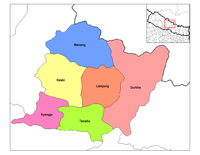
Civilization
Civilization is a sometimes controversial term that has been used in several related ways. Primarily, the term has been used to refer to the material and instrumental side of human cultures that are complex in terms of technology, science, and division of labor. Such civilizations are generally...
began at least eight or nine thousand years ago. The Pye recounts the origin of human beings and the materials and tools they used. Tamu priests still use some of these primitive utensils in their rituals. The Pye seems to have remained substantially the same over time.
The Pye records the ancestors of the Tamu, their Aji-khe, or Khe-ku, nine male ancestors; Aji-ma, or Ma-i, seven female ancestors; and Aba Kara Klye, including spiritual masters, lords, and ghosts. Tamu Pye tell how the first people lived in Cho Nasa (or Tso Nasa, Tibetan for "Nasa Lake"), a lakeside village, where they planted the first grain, barley. Then they spread to other locales such as Sa Nasa, Dwo Nasa, Si Nasa and Kro Nasa. Kro Nasa is described as being in the south, with hot and fertile climes. The northern Cho Nasa was later rich in religious activity, its inhabitants speaking Tamu-Kwyi. Other Tamu villages were influenced according to their proximity to these two northern and southern villages. The Pye contains stories about the discovery of fire and the making of the first drum among many others.
There are many possibilities for the original location of the ancestral Tamu. The ancestors of the Tamu – the Ma-i and Khe-ku seem to have represented seven lakes (female Ma-i) and nine mountain peaks (male Khe-ku). There is a traditional assumption that Cho Nasa, as described in the Pye-ta Lhu-ta, refers to a place in western Tibet, and was ringed by seven lakes and surrounded by three mountain ranges. To the south, in Xinjiang
Xinjiang
Xinjiang is an autonomous region of the People's Republic of China. It is the largest Chinese administrative division and spans over 1.6 million km2...
in Western China
Western China
Western China , refers to the western part of China. In the definition of the Chinese government, Western China covers six provinces: Gansu, Guizhou, Qinghai, Shaanxi, Sichuan, and Yunnan; one municipality: Chongqing; and three autonomous regions: Ningxia, Tibet, and Xinjiang.-Administrative...
, north of Tibet
Tibet
Tibet is a plateau region in Asia, north-east of the Himalayas. It is the traditional homeland of the Tibetan people as well as some other ethnic groups such as Monpas, Qiang, and Lhobas, and is now also inhabited by considerable numbers of Han and Hui people...
, in the Turfan Depression
Turfan Depression
The Turpan Depression or Turfan Depression is a fault-bounded trough located around and south of the city-oasis of Turpan, in the Xinjiang Autonomous Region in far western China, about 150 km southeast of the provincial capital Ürümqi. It includes the third lowest exposed point on the Earth's...
, lay Kro Nasa. As the Tamu migrated from one site to another, they would call the new site by an old name as if it were similar in some aspect (Cf. New York
New York
New York is a state in the Northeastern region of the United States. It is the nation's third most populous state. New York is bordered by New Jersey and Pennsylvania to the south, and by Connecticut, Massachusetts and Vermont to the east...
). According to the Tamu Pye, the soul of the dead is believed to go first to Koko-limar-tso, which is under water. In the Qinghai
Qinghai
Qinghai ; Oirat Mongolian: ; ; Salar:) is a province of the People's Republic of China, named after Qinghai Lake...
region of China lies a huge lake with an island in the middle called Koko Nor (or Ching Hai). It is similar to Hara Usa Nuur (one of the seven lakes) of western Mongolia, and some near-by places have names which end in "chow", conceivably derived from the Cho Nasa of almost six or seven thousand years ago, described in Tamu Pye. Similarly Sa Nasa, Two Nasa, Si Nasa and Kro Nasa could be placed in the Qinghai, Gansu
Gansu
' is a province located in the northwest of the People's Republic of China.It lies between the Tibetan and Huangtu plateaus, and borders Mongolia, Inner Mongolia, and Ningxia to the north, Xinjiang and Qinghai to the west, Sichuan to the south, and Shaanxi to the east...
, Sichuan
Sichuan
' , known formerly in the West by its postal map spellings of Szechwan or Szechuan is a province in Southwest China with its capital in Chengdu...
and Yunnan
Yunnan
Yunnan is a province of the People's Republic of China, located in the far southwest of the country spanning approximately and with a population of 45.7 million . The capital of the province is Kunming. The province borders Burma, Laos, and Vietnam.Yunnan is situated in a mountainous area, with...
regions of China respectively, running southward to Tibet and then Nepal.
Besides this document, other texts from various sources that tell the origin of Gurungs. One Nepali text from the east of Nepal, from the Rai and Limbu areas, recounts:
C.B Ghotane, a Gurung scholar has the following interpretation of Gurung history:
This research was conducted in the 1950s when most Gurungs were still living in their ancient villages with their culture and traditions were well preserved. Today, many Gurungs have urbanized or moved abroad. Gurungs nowadays struggle to preserve their language and culture. While Pignede's research can serve as a source of knowledge, its validity is controversial.
Music
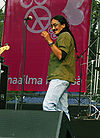
Occupations


Nepal
Nepal , officially the Federal Democratic Republic of Nepal, is a landlocked sovereign state located in South Asia. It is located in the Himalayas and bordered to the north by the People's Republic of China, and to the south, east, and west by the Republic of India...
, where they form one of the many ethnic groups in the country. In Nepal, Gurungs have and continue to play significant roles in all spheres of the country’s development. Outside Nepal, many Gurungs, some in their renowned role as Gurkha
Gurkha
Gurkha are people from Nepal who take their name from the Gorkha District. Gurkhas are best known for their history in the Indian Army's Gorkha regiments, the British Army's Brigade of Gurkhas and the Nepalese Army. Gurkha units are closely associated with the kukri, a forward-curving Nepalese knife...
soldiers, have lived and been exposed to diverse world cultures in areas as different as Bhutan
Bhutan
Bhutan , officially the Kingdom of Bhutan, is a landlocked state in South Asia, located at the eastern end of the Himalayas and bordered to the south, east and west by the Republic of India and to the north by the People's Republic of China...
, Europe
Europe
Europe is, by convention, one of the world's seven continents. Comprising the westernmost peninsula of Eurasia, Europe is generally 'divided' from Asia to its east by the watershed divides of the Ural and Caucasus Mountains, the Ural River, the Caspian and Black Seas, and the waterways connecting...
, Hong-Kong, India
India
India , officially the Republic of India , is a country in South Asia. It is the seventh-largest country by geographical area, the second-most populous country with over 1.2 billion people, and the most populous democracy in the world...
, Japan
Japan
Japan is an island nation in East Asia. Located in the Pacific Ocean, it lies to the east of the Sea of Japan, China, North Korea, South Korea and Russia, stretching from the Sea of Okhotsk in the north to the East China Sea and Taiwan in the south...
, Korea
Korea
Korea ) is an East Asian geographic region that is currently divided into two separate sovereign states — North Korea and South Korea. Located on the Korean Peninsula, Korea is bordered by the People's Republic of China to the northwest, Russia to the northeast, and is separated from Japan to the...
, and the United States of America.
In Nepal, Gurungs can be divided into two categories, highlanders and lowlanders (though Gurungs are predominantly highlanders). Highlanders living on the slopes of Himalayas
Himalayas
The Himalaya Range or Himalaya Mountains Sanskrit: Devanagari: हिमालय, literally "abode of snow"), usually called the Himalayas or Himalaya for short, is a mountain range in Asia, separating the Indian subcontinent from the Tibetan Plateau...
still rely heavily on a pastoral and agricultural way of life. They grow rice, wheat, maize, millet and potatoes, normally on terraced mountain slopes. They also derive subsistence from sheep breeding for meat and wool, using fierce mastiffs as sheepdogs.
Many Gurung families, however, have another important source of income — the pensions and salaries of family members who are in the army. Among them are the legendary fighters of the British Gurkha Regiment, who were honored with Victoria Cross
Victoria Cross
The Victoria Cross is the highest military decoration awarded for valour "in the face of the enemy" to members of the armed forces of various Commonwealth countries, and previous British Empire territories....
es for their bravery. Indeed Gurungs are renowned for their role as Gurkha soldiers, making unparalleled contributions in far flung places such as Europe during World Wars I and II, Burma, Malaysia, the Falklands, Africa
Africa
Africa is the world's second largest and second most populous continent, after Asia. At about 30.2 million km² including adjacent islands, it covers 6% of the Earth's total surface area and 20.4% of the total land area...
, and India
India
India , officially the Republic of India , is a country in South Asia. It is the seventh-largest country by geographical area, the second-most populous country with over 1.2 billion people, and the most populous democracy in the world...
. Most recently, Gurungs have participated and continue to participate in most United Nations peacekeeping missions throughout the world.
Despite many pushes and pulls of modern day life, Gurungs are increasingly eager to learn, preserve, and celebrate their distinct cultural heritage and practices. This includes not only the various belief systems and cultural practices surrounding festivals, birth, marriage, and death rituals, but also the Gurungs’ own language Tamu Kwei, generally considered a Tibeto-Burman dialect. This focus on Gurung culture continues to provide invaluable insights and inspiration toward the future.
In an ever more interdependent world, Gurungs face the challenge of balancing the preservation of their unique cultural heritage with adaptation to the demands of modern life. The majority of Gurungs still struggle for basic opportunities to improve their livelihoods. As in the past, Gurungs need to invest in opportunities that build on their well-known attributes as people who are hard working, trustworthy, adaptable, and quick-learners in meeting the challenges of modern life in Nepal and beyond its boundaries. Gurungs seek support and guidance from individuals, institutions, and governments. As of 2001, the literacy rate among Gurungs was 59.79%.
Gurkha recruitment
Shri Lil Bahadur Gurung was the first GorkhaGorkha
Gurkha are people from Nepal who take their name from the 8th century Hindu warrior-saint Guru Gorakhnath.Gurkha, Ghurkha, or Gorkha may also refer to:-People:...
to become Director of Music, Military School of Music,Pachmarhi (Madhya Pradesh) of the Indian Army. He has composed a lot of martial music for the Indian Army. He is the first Indian to get LTCL ie Licentiate diploma in band conducting from Trinity College of Music, London. Presently he is settled down in Jabalpur, India and enjoying his retired life.
Havildar Bhanbhagta Gurung
Bhanbhagta Gurung
Havildar Bhanbhagta Gurung VC was a Nepalese recipient of the Victoria Cross, the highest and most prestigious award for gallantry in the face of the enemy that can be awarded to British and Commonwealth forces, awarded for his actions while serving as a Rifleman with the 3rd Battalion of...
VC (September 1921 – 1 March 2008) (also known as Bhanbhakta Gurung) was a Nepalese recipient of the Victoria Cross, the highest and most
prestigious award for gallantry in the face of the enemy that can be awarded to British and Commonwealth forces, awarded for his actions while serving as a rifleman with the 3rd Battalion of the 2nd Gurkha Rifles in Burma during the Second World War.
Lachhiman Gurung
Lachhiman Gurung
Lachhiman Gurung VC was a Nepalese recipient of the Victoria Cross, the highest and most prestigious award for gallantry in the face of the enemy that can be awarded to British and Commonwealth forces.-Details:...
, VC (born 30 December 1917) is a Nepalese recipient of the Victoria Cross, the highest and most prestigious award for gallantry in the face of the enemy that can be awarded to British and Commonwealth forces.
Omendra Gurung (Pangi-Lama) is the first Nepalese Gurung (tamu)Police Community Support Officer in the UK. He is from Baglung Pani 5 Nazare (Samrong) of Lamjung West Nepal.
Lifestyle
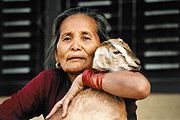
Herding
Herding is the act of bringing individual animals together into a group , maintaining the group and moving the group from place to place—or any combination of those. While the layperson uses the term "herding", most individuals involved in the process term it mustering, "working stock" or...
, trans-Himalayan trade and farming. In the 19th and early 20th century, many Gurung were recruited to serve in the British
United Kingdom
The United Kingdom of Great Britain and Northern IrelandIn the United Kingdom and Dependencies, other languages have been officially recognised as legitimate autochthonous languages under the European Charter for Regional or Minority Languages...
and India
India
India , officially the Republic of India , is a country in South Asia. It is the seventh-largest country by geographical area, the second-most populous country with over 1.2 billion people, and the most populous democracy in the world...
n Gurkha
Gurkha
Gurkha are people from Nepal who take their name from the Gorkha District. Gurkhas are best known for their history in the Indian Army's Gorkha regiments, the British Army's Brigade of Gurkhas and the Nepalese Army. Gurkha units are closely associated with the kukri, a forward-curving Nepalese knife...
regiments. Today, the Singapore
Singapore
Singapore , officially the Republic of Singapore, is a Southeast Asian city-state off the southern tip of the Malay Peninsula, north of the equator. An island country made up of 63 islands, it is separated from Malaysia by the Straits of Johor to its north and from Indonesia's Riau Islands by the...
Police, Brunei
Brunei
Brunei , officially the State of Brunei Darussalam or the Nation of Brunei, the Abode of Peace , is a sovereign state located on the north coast of the island of Borneo, in Southeast Asia...
reserve units and the French Foreign Legion
French Foreign Legion
The French Foreign Legion is a unique military service wing of the French Army established in 1831. The foreign legion was exclusively created for foreign nationals willing to serve in the French Armed Forces...
incorporate ethnically Gurung members. While serving in the British Army
British Army
The British Army is the land warfare branch of Her Majesty's Armed Forces in the United Kingdom. It came into being with the unification of the Kingdom of England and Scotland into the Kingdom of Great Britain in 1707. The new British Army incorporated Regiments that had already existed in England...
they have earned more than 6 Victoria Cross
Victoria Cross
The Victoria Cross is the highest military decoration awarded for valour "in the face of the enemy" to members of the armed forces of various Commonwealth countries, and previous British Empire territories....
awards. Gurungs are not only restricted to military occupations, many live in urban areas and are employed in all types of labor, business and professional services.
Gurungs trace their descent patrilineally, organized into two groups, or moieties of patrilineal clans.
A noted Gurung tradition is the institution of Rodhi where teenagers form fictive kinship
Fictive kinship
Fictive kinship is a term used by anthropologists and ethnographers to distinguish between forms of kinship or social ties that are based on neither consanguinal nor affinal ties...
bonds and become Rodhi members to socialize, perform communal tasks, and find marriage partners. But the institution is rarely in existence because of its notoriety in the community. 'Rodhi' literally means weaving and making of baskets.
Generally speaking, the Gurungs are divided into two castes (Jaat in the local tongue); Chaar and the Sohra. Within the Chaar jaat there exists further sub-divisions: namely, Ghale, Ghotane, Lama and Lamichhaney. Their cultural norms and values are greatly influenced by the Tibetans. Tibetan priests perform all rituals, and Chaar caste members are mainly Buddhists. Gurungs are very homogenous in society, whereby a Gurung is typically married to another Gurung people. A male who belongs to the Chaar jaat is entitled to marry any Gurung women however, a male who belongs to the Sohra jaat(16 caste)would find himself limited to find only the Sohra jaat bride . This practice has existed for a long time without contention and to this day, this practice is still very ubiquitous, though less heightened.
The Sohra jaat contains 16 castes, however there exist more than 50 further subdivisions, named by their occupations. Their tradition mainly relies on the Pye-taa Lhu-taa. They have their own priests, ghyabrey (or klihbri) and pachyu (or panju) who perform traditional Gurung Dharma
Gurung Dharma
Gurung Dharma describes the traditional shamanistic religion of the Gurung people of Nepal. This religion shares aspects with the Tibetan religion Bön and is often referred to as "Bön"; however, there exist significant distinctions between Gurung Dharma and Bön...
rituals.
Despite Nepali's being a South-Asian, Gurung people bears similar physical traits like Chinese, Mongoloid or Tibetans. Typically, a Gurung person have dark-brown almond eyes, double eye-lids, dark hair, high cheekbones, full lips, small jawline, light skin, and a fairly elevated nose-bridge.
A study has noted that a Gurkha mercenary in Singapore or Great Britain would typically support up to five relatives from home, despite already having to support their immediate family members. The foreign remittance of the Gurkha's pension fund as well as disposable income has benefited Nepal's Economy to some extent.
A notable Gurung person, outside of Gurung's stereotypical career, is Designer Prabal Gurung, a Singapore-born, Nepali-American Fashion Designer. Not surprisingly, his father was also one of the brave Gurkha soldier who served Singapore.
Religion
Centuries of cultural influence from Tibet and its northern neighbours – which adopted the Tibetan culture to a heavy extent resulted in many Gurungs gradually embracing Tibetan BuddhismTibetan Buddhism
Tibetan Buddhism is the body of Buddhist religious doctrine and institutions characteristic of Tibet and certain regions of the Himalayas, including northern Nepal, Bhutan, and India . It is the state religion of Bhutan...
–particularly among Gurungs in the Manang
Manang
Manang is a town in the Manang District of Nepal. It is located at 28°40'0N 84°1'0E with an altitude of . At the time of the 1991 Nepal census it had a population of 391 people living in 120 individual households....
region – over the centuries, particularly the Nyingma
Nyingma
The Nyingma tradition is the oldest of the four major schools of Tibetan Buddhism . "Nyingma" literally means "ancient," and is often referred to as Nga'gyur or the "old school" because it is founded on the first translations of Buddhist scriptures from Sanskrit into Tibetan, in the eighth century...
school. Gurungs generally believe in Buddha and bodhisattvas. Adherents also call upon Buddhist lama
Lama
Lama is a title for a Tibetan teacher of the Dharma. The name is similar to the Sanskrit term guru .Historically, the term was used for venerated spiritual masters or heads of monasteries...
s to perform infant purification, seasonal agricultural, and funerary rites, as well as house blessing ceremonies. According to the 2001 Nepal Census, 69.03% of the ethnic Gurung were Buddhists, 28.75% were Hindus and 0.66% were Christians. Gurungs practice a form of Tibetan Buddhism
Tibetan Buddhism
Tibetan Buddhism is the body of Buddhist religious doctrine and institutions characteristic of Tibet and certain regions of the Himalayas, including northern Nepal, Bhutan, and India . It is the state religion of Bhutan...
heavily influenced by pre-Buddhist Tibetan religion (Bön). Characteristics of this influence include non-Buddhist belief in local deities and in an afterlife in the Land of Ancestors. Other traditional Gurung beliefs include spirit possession, supernatural forest creatures, shapeless wraiths, and spirits of humans that died violently, which populate locales. Gurung villages have their own local deities.
Gurung Dharma
Gurung Dharma
Gurung Dharma describes the traditional shamanistic religion of the Gurung people of Nepal. This religion shares aspects with the Tibetan religion Bön and is often referred to as "Bön"; however, there exist significant distinctions between Gurung Dharma and Bön...
describes the traditional shamanistic
Shamanism
Shamanism is an anthropological term referencing a range of beliefs and practices regarding communication with the spiritual world. To quote Eliade: "A first definition of this complex phenomenon, and perhaps the least hazardous, will be: shamanism = technique of ecstasy." Shamanism encompasses the...
religion of the Gurung people of Nepal
Nepal
Nepal , officially the Federal Democratic Republic of Nepal, is a landlocked sovereign state located in South Asia. It is located in the Himalayas and bordered to the north by the People's Republic of China, and to the south, east, and west by the Republic of India...
. This religion shares aspects of the Tibet
Tibet
Tibet is a plateau region in Asia, north-east of the Himalayas. It is the traditional homeland of the Tibetan people as well as some other ethnic groups such as Monpas, Qiang, and Lhobas, and is now also inhabited by considerable numbers of Han and Hui people...
an Bön religion, and is often referred to as "Bön," however there exist significant distinctions between Gurung Dharma and Bön proper. Contemporary shamanistic rituals of Gurung Dharma such as blood offering
Bloodletting
Bloodletting is the withdrawal of often little quantities of blood from a patient to cure or prevent illness and disease. Bloodletting was based on an ancient system of medicine in which blood and other bodily fluid were considered to be "humors" the proper balance of which maintained health...
rituals and ancestor and nature worship
Nature worship
Nature worship describes a variety of religious, spiritual and devotional practices that focus on natural phenomenon. A nature deity can be in charge of nature, the biosphere, the cosmos or the universe. Nature worship can be found in panentheism, pantheism, deism, polytheism, animism, totemism,...
are no longer practiced by Tibetan Bönpa. Priestly practitioners of Gurung Dharma include lama
Lama
Lama is a title for a Tibetan teacher of the Dharma. The name is similar to the Sanskrit term guru .Historically, the term was used for venerated spiritual masters or heads of monasteries...
s, klihbri, and panju. Shamanistic elements among the Gurungs remain strong and most Gurungs often embrace Buddhist and Bön rituals in all communal activities. Gurung Dharma in its purest form is now virtually extinct, however the religion is preserved to a large extent in Gurung traditions.

